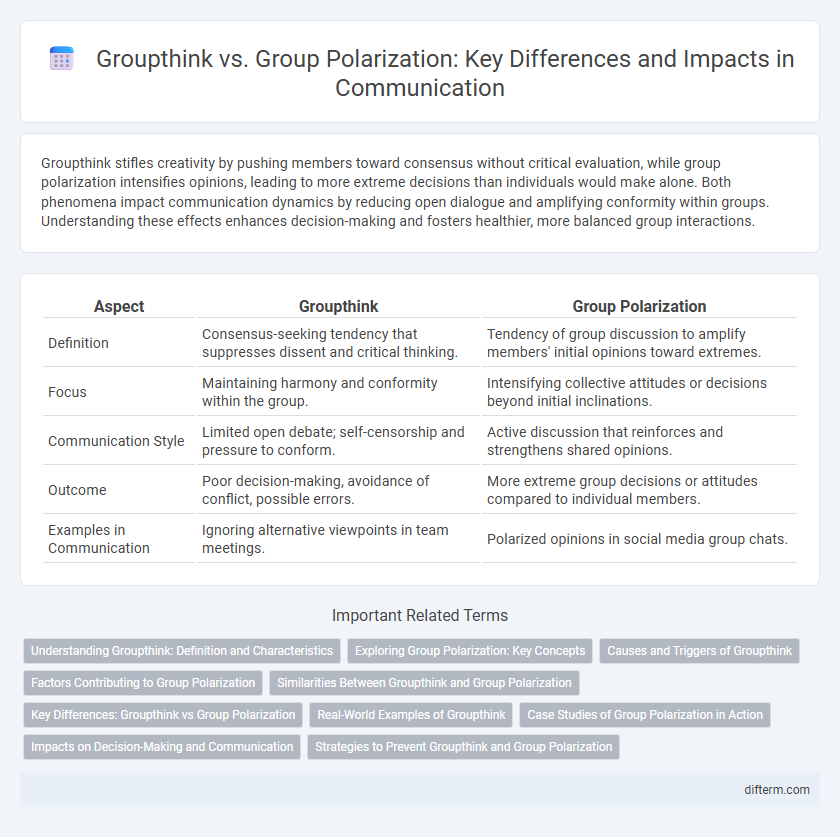Groupthink stifles creativity by pushing members toward consensus without critical evaluation, while group polarization intensifies opinions, leading to more extreme decisions than individuals would make alone. Both phenomena impact communication dynamics by reducing open dialogue and amplifying conformity within groups. Understanding these effects enhances decision-making and fosters healthier, more balanced group interactions.
Table of Comparison
| Aspect | Groupthink | Group Polarization |
|---|---|---|
| Definition | Consensus-seeking tendency that suppresses dissent and critical thinking. | Tendency of group discussion to amplify members' initial opinions toward extremes. |
| Focus | Maintaining harmony and conformity within the group. | Intensifying collective attitudes or decisions beyond initial inclinations. |
| Communication Style | Limited open debate; self-censorship and pressure to conform. | Active discussion that reinforces and strengthens shared opinions. |
| Outcome | Poor decision-making, avoidance of conflict, possible errors. | More extreme group decisions or attitudes compared to individual members. |
| Examples in Communication | Ignoring alternative viewpoints in team meetings. | Polarized opinions in social media group chats. |
Understanding Groupthink: Definition and Characteristics
Groupthink is a psychological phenomenon where the desire for harmony in a decision-making group leads to irrational or dysfunctional outcomes. Key characteristics include suppression of dissenting opinions, illusion of unanimity, and pressure to conform, which impair critical evaluation of alternatives. Understanding these traits helps prevent poor decisions by encouraging open dialogue and critical analysis within teams.
Exploring Group Polarization: Key Concepts
Group polarization occurs when members of a discussion group adopt more extreme positions following group interaction, intensifying their initial attitudes. This phenomenon stems from social comparison and persuasive argument processes, leading to a shift toward stronger consensus or riskier decisions. Understanding group polarization is crucial in communication studies to improve decision-making quality and mitigate extreme outcomes.
Causes and Triggers of Groupthink
Groupthink often arises in cohesive groups with high pressure for conformity, where members prioritize consensus over critical evaluation to maintain harmony. Causes include strong, directive leadership, isolation from outside opinions, and stressful decision-making environments that limit dissent. Triggers involve time constraints, homogeneity of group members, and a lack of impartial leadership encouraging open dialogue and diverse perspectives.
Factors Contributing to Group Polarization
Group polarization intensifies decision-making as members of a group share similar opinions, reinforcing and amplifying prevailing attitudes through social comparison and persuasive arguments. Factors contributing to group polarization include the desire for social approval, exposure to novel information favoring a dominant perspective, and increased group cohesion that diminishes dissenting viewpoints. This phenomenon contrasts with groupthink, where the drive for consensus suppresses critical evaluation and diversity of opinion.
Similarities Between Groupthink and Group Polarization
Groupthink and group polarization both involve the influence of group dynamics on individual decision-making, leading to a convergence of opinions within a group. Both phenomena result in heightened consensus and reduced critical evaluation of alternative ideas, often driven by social conformity and desire for cohesion. These cognitive biases contribute to intensified group attitudes and potentially flawed collective judgments.
Key Differences: Groupthink vs Group Polarization
Groupthink primarily occurs when cohesive groups prioritize consensus over critical evaluation, leading to flawed decision-making due to suppressed dissenting opinions. In contrast, group polarization refers to the tendency of group discussions to amplify members' initial inclinations, resulting in more extreme positions. Key differences include groupthink's emphasis on conformity and avoidance of conflict, whereas group polarization highlights ideological intensification within the group dynamic.
Real-World Examples of Groupthink
Groupthink occurs when cohesive groups prioritize harmony over critical analysis, leading to poor decision-making as seen in the Bay of Pigs invasion where U.S. advisors ignored dissenting opinions. The Challenger Space Shuttle disaster also exemplifies groupthink, with engineers' concerns about O-ring failures being overridden by management consensus. In both cases, the suppression of conflicting viewpoints resulted in significant real-world consequences, highlighting the dangers of groupthink in high-stakes communication settings.
Case Studies of Group Polarization in Action
Case studies of group polarization reveal how discussions within like-minded groups intensify members' preexisting opinions, leading to more extreme decisions. Research in juror deliberations shows that group polarization often results in harsher verdicts when individuals with mild initial opinions collectively shift toward stronger consensus. Studies in political communication highlight how social media echo chambers contribute to polarization by reinforcing and amplifying shared beliefs among group members.
Impacts on Decision-Making and Communication
Groupthink often leads to poor decision-making by suppressing dissenting opinions and fostering conformity, which limits critical evaluation of alternatives. In contrast, group polarization intensifies members' initial attitudes, resulting in more extreme decisions and heightened communication biases. Both phenomena negatively impact communication clarity and hinder balanced, effective decision processes within groups.
Strategies to Prevent Groupthink and Group Polarization
Implementing structured decision-making processes and encouraging open dialogue helps prevent groupthink by reducing conformity pressure and promoting diverse viewpoints. Assigning a devil's advocate in discussions challenges consensus and uncovers hidden assumptions, mitigating group polarization effects. Fostering an environment where dissent is valued and members feel safe to express minority opinions strengthens critical evaluation and balanced decision outcomes.
groupthink vs group polarization Infographic

 difterm.com
difterm.com